Slippery gym floors holding you back? Dreaming of a workout space that’s both functional and inspiring? Discover the power of artificial grass gym turf and transform your fitness!
Choosing the best artificial grass gym turf depends on your gym’s activities and budget. Generally, look for short pile (0.5-1 inch), durable fibers like polyethylene or nylon, and consider infill options based on your needs. Brands like PLAE, NexGen, and FieldTurf offer excellent gym-specific turfs balancing performance and longevity.

Finding the perfect gym turf can seem complex, but I’m here to simplify it. Let’s dive into a comprehensive guide, exploring top brands, installation tips, and everything you need to make the best choice for your fitness space.
What is the best surface for a gym floor? – A Broader Look
Gym floors endure relentless pounding. From dropped weights to high-intensity workouts, the surface must be resilient and safe. But what flooring truly reigns supreme in the gym environment?
Artificial grass turf is a leading contender for the best gym floor surface, offering a unique blend of durability, traction, and comfort. While rubber flooring excels in weightlifting zones and specialized sports flooring caters to specific activities, gym turf’s versatility and aesthetic appeal make it a top overall choice for many modern gyms.
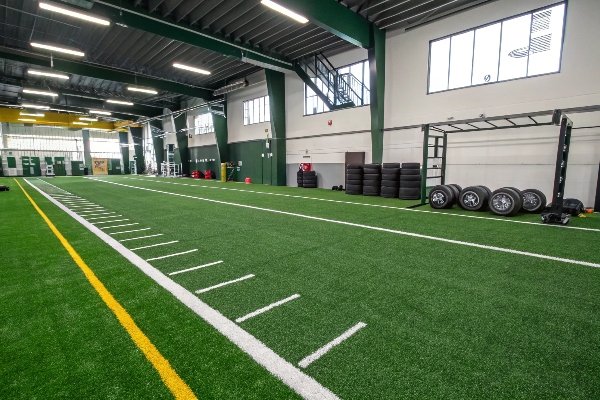
When evaluating gym flooring, it’s crucial to consider more than just aesthetics. Performance, safety, and longevity are paramount. Let’s compare various options and see how artificial turf stacks up.
Beyond the Basics: Comparing Gym Flooring Options
While turf is excellent, other surfaces also have their place. Here’s a quick comparison:
- Rubber Flooring: The workhorse of weight rooms. Incredibly durable, impact-resistant, and sound-absorbing. Ideal for free weight areas and heavy equipment zones. Can be less comfortable for floor exercises and less visually appealing for some.
- Specialized Sports Flooring (PVC/Polyurethane): Designed for specific sports like basketball or volleyball. Offers excellent shock absorption and ball bounce. Less versatile for general fitness and strength training.
- Foam Tiles: Budget-friendly and easy to install, good for home gyms or light-use areas. Less durable for heavy weights and high-impact activities. Can be prone to tearing and indentation.
- Carpet: Comfortable and warm, but not ideal for most gyms due to hygiene concerns, durability issues, and lack of traction. Difficult to clean and maintain in a sweaty gym environment.
- Artificial Grass Turf: Versatile, durable, good traction, aesthetically pleasing. Excellent for functional fitness, agility, sled tracks, and general workout areas. May require specific infill choices and potentially padding for optimal performance.
For a multi-purpose gym, artificial turf often strikes the best balance. It offers a good blend of the benefits of other flooring types without their major drawbacks.
Is artificial grass good for the gym? – Unpacking the Benefits
Artificial grass might sound unconventional, but it’s a smart and increasingly popular choice. Is this just a trend, or does artificial turf genuinely enhance the gym experience?
Yes, artificial grass is exceptionally well-suited for gyms, offering a range of advantages that traditional flooring can’t match. Its durability, comfort, visual appeal, and functional benefits for various exercises make it a smart investment for any fitness facility aiming for a modern and high-performance environment.
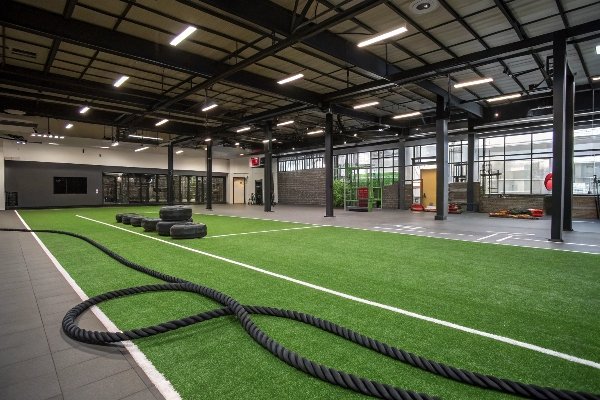
My initial doubts about gym turf vanished once I experienced its benefits firsthand. It’s not just about looks; it’s about creating a better workout environment.
Top Advantages of Artificial Grass Gym Turf:
- Enhanced Aesthetics and Atmosphere: Turf brings a fresh, outdoor feel indoors. The green color is energizing and visually appealing, creating a more motivating workout space compared to sterile rubber or concrete.
- Superior Traction and Grip: Essential for dynamic movements, sled pushes, and agility drills. Turf provides excellent grip, reducing slip risks and enhancing performance.
- Comfort and Shock Absorption (with padding): While turf itself isn’t heavily cushioned, when paired with appropriate padding, it offers good shock absorption, reducing joint strain and fatigue during workouts.
- Versatility for Diverse Training: Ideal for functional fitness, CrossFit, agility training, sled work, bodyweight exercises, and even yoga. It accommodates a wide range of activities.
- Durability and Longevity: High-quality gym turf is designed to withstand heavy use, foot traffic, and equipment. It’s a long-term flooring solution.
- Low Maintenance: Easy to clean and maintain compared to carpet or natural grass. Requires minimal upkeep beyond regular vacuuming or brushing.
- Noise Reduction: Helps absorb impact noise, creating a slightly quieter and more pleasant workout environment.
Is turf or rubber flooring better for gyms? – A Detailed Comparison
Turf and rubber flooring are the titans of the gym world. Choosing between them can be tough. Let’s break down their strengths and weaknesses to determine which flooring best suits your needs.
The "better" choice between turf and rubber depends heavily on the gym area’s primary function. Rubber flooring remains superior for heavy weightlifting zones due to its unmatched impact resistance. Turf excels in functional training, agility, and sled track areas, offering greater versatility and traction. Many gyms strategically combine both for optimal functionality.

This isn’t an "either/or" situation. Often, the best gym designs incorporate both turf and rubber to maximize functionality across different training zones.
Turf vs. Rubber: Head-to-Head Breakdown
| Feature | Artificial Grass Turf | Rubber Flooring |
|---|---|---|
| Best For | Functional Fitness, Agility, Sled Tracks, General Workout | Weightlifting, Heavy Equipment, High Impact Zones |
| Durability | High (Gym-Specific Turf) | Very High |
| Impact Resistance | Moderate (Can be enhanced with padding) | Excellent |
| Traction/Grip | Excellent | Good to Excellent (Textured Rubber) |
| Comfort | Good (Especially with padding) | Fair to Good (Density varies) |
| Versatility | Very High | Moderate |
| Aesthetics | High (Natural, Inviting) | Moderate (Functional, Industrial) |
| Maintenance | Low | Low |
| Cost | Moderate to High | Moderate to High |
Recommendation:
- Weightlifting Areas: Rubber flooring is the clear winner for platforms, racks, and free weight zones due to its superior impact resistance and protection for subfloors.
- Functional Training Zones: Turf is ideal for sled tracks, agility drills, bodyweight circuits, and group fitness classes.
- Cardio Areas: Either rubber or turf can work, depending on the type of cardio equipment and desired feel. Rubber is often used under treadmills and ellipticals, while turf can create a more dynamic feel for open cardio spaces.
- Hybrid Gyms: Consider a strategic combination. Rubber in weight areas, turf in functional zones, and potentially specialized flooring for specific studios (yoga, spin, etc.).
Who makes the highest quality artificial turf? – Top Brands and Products
Quality varies greatly in the artificial turf market. For a gym, you want turf that can endure heavy use and maintain its performance. Which brands consistently deliver top-tier, gym-ready artificial grass?
Several brands are recognized for producing high-quality artificial turf suitable for demanding gym environments. Leading names include PLAE, NexGen, Turf Solutions Group, FieldTurf, and Greatmats. These manufacturers offer product lines specifically designed for fitness applications, ensuring durability, performance, and longevity.

Choosing a reputable brand is paramount. Let’s explore some top manufacturers and their popular gym turf product lines. This is not an exhaustive list, but represents some of the leaders in the industry.
Top Artificial Grass Gym Turf Brands and Products:
| Brand | Product Line Examples | Key Features | Best Use Scenarios | Pros | Cons |
|---|---|---|---|---|---|
| PLAE | Attack Turf, React Turf | High-density fibers, durable, minimal infill, integrated or optional padding | High-performance gyms, CrossFit boxes, strength & conditioning | Exceptional durability, performance-focused, wide range of options | Premium price point, may require professional installation for complex layouts |
| NexGen | NX50, NX60, Matrix | Polyethylene/Nylon blends, various pile heights, padded options, durable | Commercial gyms, functional training areas, sled tracks | Good balance of durability and comfort, variety of styles and price points | Some lines may require infill, not as specialized as PLAE for elite performance |
| Turf Solutions Group | Performance Turf, Fit Turf | Durable polyethylene, short pile, non-infill options, easy installation | Home gyms, smaller studios, budget-conscious gyms | Cost-effective, DIY-friendly options, good for general fitness use | May not be as robust for extremely heavy, high-traffic commercial settings |
| FieldTurf | Vertex Turf, DoublePlay | High-end polyethylene, durable, infill options, sports-grade performance | Large commercial gyms, sports training facilities, performance centers | Proven track record in sports turf, high durability, professional-grade | Higher cost, may be overkill for smaller gyms, often requires professional install |
| Greatmats | Gym Turf Rolls, Interlocking Turf Tiles | Polypropylene/Polyethylene blends, roll or tile format, easy install | Home gyms, temporary setups, smaller functional areas | Affordable, easy DIY installation, modular options, good for home use | Durability may be lower than premium brands, less specialized for intense commercial use |
Note: This table is a simplified overview. Always research specific product specifications and read reviews before making a decision. Request samples to test the turf’s feel and performance in your environment.
What are the key differences between low pile and high pile gym turf? – Choosing the Right Height
Pile height – a seemingly minor detail – significantly impacts gym turf performance. Low pile and high pile turfs offer distinct feels and functionalities. Which pile height is the optimal choice for your gym’s activities?
For most gym applications, low pile turf (0.5-1 inch) is the ideal choice. It provides a firm, stable, and durable surface crucial for agility, sled pushes, and functional training. High pile turf, while softer, lacks the stability needed for dynamic gym workouts and is better suited for landscaping or purely aesthetic purposes.

Pile height isn’t just about looks; it’s about performance and safety. Let’s delve deeper into why low pile turf is generally preferred for gyms.
Low Pile vs. High Pile Gym Turf: Performance Matters
| Feature | Low Pile Turf (0.5-1 inch) | High Pile Turf (Over 1 inch) |
|---|---|---|
| Stability | High – Firm, stable surface | Low – Less stable, can feel spongy |
| Traction | Excellent | Good, but can be less consistent due to fiber length |
| Durability (Gym Use) | High – More resistant to matting and wear | Lower – More prone to matting and wear under heavy gym use |
| Best For Gym Activities | Agility, Sled Pushes, Functional Training, High-Traffic Areas | Not recommended for most dynamic gym workouts |
| Comfort | Moderate – Can be enhanced with padding | Higher – Softer, more plush feel |
| Maintenance | Easier to clean and maintain | Can trap more debris, slightly more difficult to clean |
| Ideal Gym Use | General Gym Flooring, Functional Training Zones, Sled Tracks | Primarily aesthetic or very low-impact, decorative gym areas only |
Key Takeaway: For a functional and high-performance gym, prioritize low pile turf. It provides the stability, durability, and traction necessary for a wide range of workout activities. High pile turf is generally unsuitable for most gym applications due to its instability and lower durability under gym conditions.
How does the durability of polyethylene and polypropylene turf compare? – Fiber Face-Off
Fiber type is a critical factor determining gym turf durability. Polyethylene (PE) and polypropylene (PP) are common choices, but their performance differs significantly. Which fiber holds up best under the rigors of a gym environment?
Polyethylene (PE) turf generally offers superior durability and resilience compared to polypropylene (PP) turf, making it the preferred choice for demanding gym environments. PE turf withstands heavy foot traffic, sled pushes, and repeated use more effectively, justifying its higher cost for long-term gym flooring solutions. PP turf, while more budget-friendly, is less durable for high-intensity gym applications.
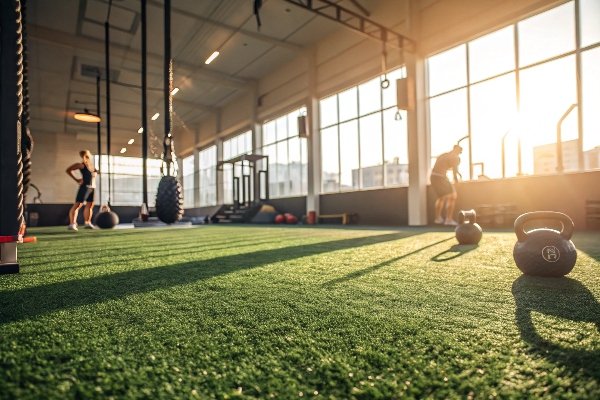
The choice of fiber directly impacts your turf’s lifespan and performance. Let’s compare polyethylene and polypropylene in detail for gym applications.
Polyethylene (PE) vs. Polypropylene (PP) Turf Fibers for Gyms:
| Feature | Polyethylene (PE) Turf | Polypropylene (PP) Turf |
|---|---|---|
| Durability | High – Excellent wear resistance, long-lasting | Moderate – Lower wear resistance, less durable for heavy use |
| Resilience | High – Good springback, maintains shape | Lower – Less resilient, prone to matting and flattening |
| Feel | Softer, more comfortable underfoot | Slightly more abrasive, less comfortable |
| UV Resistance | Good – Holds color well in sunlight (less relevant indoors) | Fair to Good – Can fade over time, especially in direct sunlight |
| Cost | Higher | Lower |
| Best for Gyms | High-traffic gyms, functional training areas, sled tracks | Home gyms, light-use studios, budget-conscious installations |
Recommendation: For commercial gyms, high-intensity training facilities, or any gym expecting heavy use, polyethylene (PE) turf is the more durable and longer-lasting investment. While polypropylene (PP) turf is cheaper upfront, its lower durability may lead to faster wear and the need for replacement sooner, potentially costing more in the long run, especially when considering labor and downtime for replacement.
Installation Guide: DIY vs. Professional & Key Steps
Ready to install gym turf? Deciding between DIY and professional installation is a crucial first step. Let’s explore your options and the essential steps for a successful turf installation.
For smaller, simpler gym areas or home gyms, DIY turf installation can be a cost-effective option. However, for larger commercial gyms or complex layouts, professional installation is highly recommended to ensure proper seaming, secure adhesion, and optimal longevity. Proper sub-base preparation is critical for both DIY and professional installations.
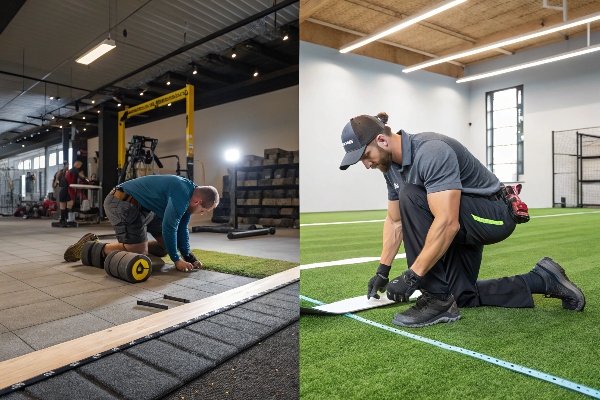
Let’s break down the installation process and help you decide if DIY or professional installation is right for you.
DIY vs. Professional Gym Turf Installation:
| Factor | DIY Installation | Professional Installation |
|---|---|---|
| Gym Size & Complexity | Small areas, simple layouts, home gyms | Large areas, complex layouts, commercial gyms |
| Skill Level | Basic DIY skills, comfortable with measuring & cutting | Specialized skills, experience with turf installation |
| Time Commitment | Significant – Requires time and effort | Minimal – Professionals handle the entire process |
| Cost | Lower upfront cost (save on labor) | Higher upfront cost (includes labor) |
| Quality & Warranty | Relies on DIY skill, potential for errors | Ensures proper installation, manufacturer warranties often apply |
| Tools & Equipment | Basic tools (utility knife, measuring tape, adhesive) | Specialized tools (seaming irons, power stretchers, etc.) |
DIY Installation Steps (Simplified):
- Sub-base Preparation: Ensure a clean, level, and dry subfloor (concrete, plywood). Remove debris and fill any cracks or holes. Consider a moisture barrier if needed.
- Turf Unrolling and Acclimation: Unroll the turf and let it acclimate to the gym environment for 24-48 hours to relax wrinkles.
- Cutting and Fitting: Measure and cut the turf to fit the gym area, leaving slight overlaps for seaming. Use a sharp utility knife and straight edge.
- Seaming (if needed): Join turf pieces using seaming tape or adhesive, ensuring tight, invisible seams.
- Adhesive Application: Apply turf adhesive to the subfloor according to the manufacturer’s instructions.
- Turf Laying and Securing: Carefully lay the turf onto the adhesive, smoothing out any wrinkles or bubbles. Roll with a heavy roller to ensure good adhesion.
- Infill (if applicable): Distribute infill evenly using a spreader and brush it into the turf fibers.
- Final Touches: Trim any excess turf edges and clean up the area.
Professional Installation Advantages:
- Expertise and Experience: Professionals ensure proper installation techniques, minimizing errors and maximizing turf lifespan.
- Specialized Tools & Equipment: They have the right tools for precise cutting, seaming, and installation.
- Warranty Compliance: Professional installation often ensures manufacturer warranties remain valid.
- Time Savings: Saves you significant time and effort.
- Seamless Finish: Professionals can create virtually seamless installations, especially in large areas.
Sub-base Preparation is Key: Regardless of DIY or professional installation, proper sub-base preparation is crucial for turf adhesion, longevity, and a smooth, even surface. Ensure your subfloor is clean, level, dry, and structurally sound. Consider a moisture barrier, especially in basements or areas prone to dampness.
Infill vs. Non-Infill Systems: Choosing the Right Fill
Infill – those tiny particles nestled within artificial grass fibers – plays a significant role in turf performance. But do you need infill for gym turf? And if so, what type is best? Let’s explore the world of infill and non-infill gym turf systems.
For most gym applications, especially indoor facilities, low-infill or non-infill turf systems are generally preferred. They minimize mess, reduce maintenance, and still provide excellent traction and support. If infill is desired, sand or specialized synthetic infills are common choices, while rubber crumb infill is less ideal for indoor gyms due to potential mess and odor concerns.
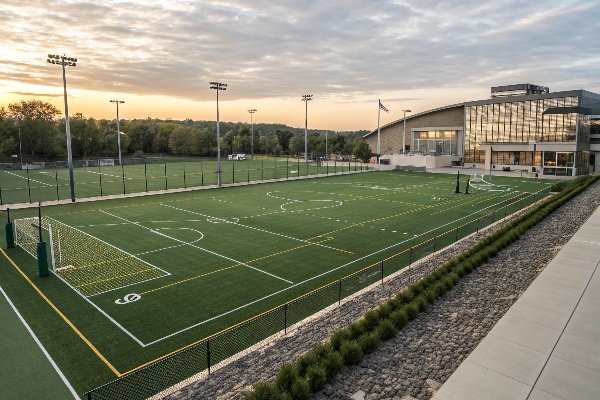
Infill type significantly affects turf performance, maintenance, and suitability for different gym activities.
Types of Gym Turf Infill:
- No Infill (Non-Infill): Turf fibers are densely constructed to stand upright without needing infill for support. Ideal for indoor gyms, minimal mess, low maintenance, good for agility and functional training. May feel slightly firmer than infilled turf.
- Sand Infill: Silica sand is a common and affordable infill. Provides stability and support to the fibers. Can be slightly abrasive, may require periodic top-ups. Better suited for outdoor or less sensitive indoor environments.
- Rubber Crumb Infill (Recycled Tire Rubber): Offers good cushioning and shock absorption. Often used in sports fields. Less ideal for indoor gyms due to potential odor (especially in warm conditions), can track and scatter, and may have environmental concerns.
- Specialized Synthetic Infill (e.g., Acrylic Coated Sand, Organic Infill): Designed for improved performance, reduced dust, and sometimes eco-friendliness. Acrylic coated sand reduces abrasion and dust. Organic infills (e.g., cork, coconut fiber) are newer eco-friendly options, but may have different durability and maintenance profiles.
Infill Pros and Cons for Gyms:
| Infill Type | Pros | Cons | Best Gym Use Cases |
|---|---|---|---|
| Non-Infill | Minimal mess, low maintenance, good traction, clean look | Can feel slightly firmer, may be more expensive upfront | Indoor gyms, functional training, agility, sled tracks, studios where cleanliness is key |
| Sand Infill | Affordable, adds stability, good for outdoor/less sensitive areas | Can be abrasive, may track, requires periodic top-ups, can compact over time | Budget-conscious gyms, outdoor training areas, less critical indoor spaces |
| Rubber Crumb | Good cushioning, shock absorption | Potential odor, can track and scatter, environmental concerns, messier | Outdoor sports fields, high-impact CrossFit gyms (less ideal for indoor) |
| Specialized Synthetic | Improved performance, reduced dust, potentially eco-friendly, varied | Can be more expensive, performance varies by type | Indoor gyms seeking specific performance benefits, eco-conscious facilities |
Recommendation for Gyms: For indoor gyms, especially those prioritizing cleanliness and low maintenance, non-infill or very low-infill systems are generally the best choice. If infill is desired for added stability or cushioning, consider sand or specialized synthetic infills, but be mindful of potential mess and maintenance, especially with rubber crumb infill indoors.
Budget and Cost Analysis: Making it Affordable
Gym flooring is an investment, and budget is a key consideration. What’s the realistic cost of artificial grass gym turf? Let’s break down the expenses and explore budget-friendly options.
The cost of artificial grass gym turf varies widely based on quality, fiber type, pile height, brand, and installation. Expect to pay roughly $3 to $12+ per square foot for the turf material itself. Installation costs can add another $2 to $8+ per square foot, depending on DIY vs. professional installation and site complexity. Long-term maintenance costs for turf are generally low.
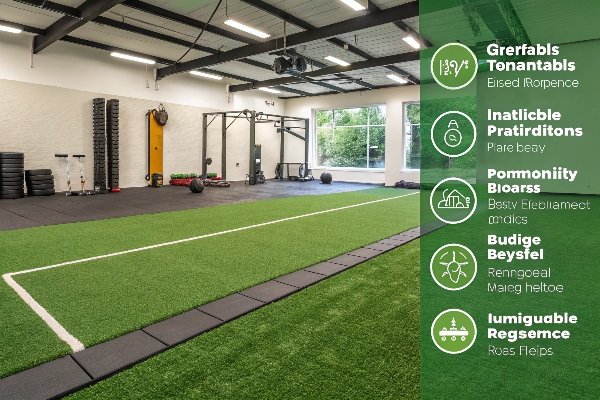
Let’s dive into the cost components and strategies for budgeting your gym turf project.
Gym Turf Cost Breakdown:
- Turf Material Cost: Ranges from approximately $3 to $12+ per square foot.
- Lower end ($3-$6/sq ft): Entry-level polypropylene or polyethylene turf, often lower pile height, may be suitable for home gyms or light-use areas. Brands like Greatmats offer budget-friendly options.
- Mid-range ($6-$9/sq ft): Good quality polyethylene turf, durable for commercial gyms, various pile heights and styles. Brands like NexGen offer a good balance of quality and price.
- Higher end ($9-$12+/sq ft): Premium polyethylene or nylon blends, high-density fibers, specialized gym turf designed for high-performance and longevity. Brands like PLAE and FieldTurf are in this range.
- Installation Cost: Ranges from approximately $2 to $8+ per square foot.
- DIY Installation: Saves on labor costs, but requires your time and effort. Cost primarily includes adhesive, seaming tape, and tools (if needed).
- Professional Installation: Adds labor costs but ensures proper installation and may include site preparation, seaming, securing, and cleanup. Cost varies by region and installer.
- Infill Cost (if applicable): Sand infill is relatively inexpensive. Specialized synthetic infills can add to the overall cost. Non-infill systems eliminate infill costs.
- Padding/Underlayment (optional): Adds cost but enhances comfort and shock absorption. Padding costs vary by thickness and material.
- Long-Term Maintenance Costs: Generally low for turf. Primarily involves vacuuming, brushing, and occasional cleaning. Lower than maintaining natural grass or replacing worn-out rubber flooring frequently.
Budget-Friendly Tips:
- DIY Installation (if feasible): Significantly reduces upfront costs if you are comfortable with DIY projects.
- Choose Budget-Friendly Turf Options: Explore polypropylene or entry-level polyethylene turf for less demanding areas or home gyms. Consider brands like Turf Solutions Group or Greatmats for more affordable options.
- Consider Smaller Rolls or Tiles: Purchasing smaller rolls or interlocking tiles can be more cost-effective for smaller gym areas and reduces waste.
- Minimize Infill Costs: Opt for non-infill or low-infill systems to reduce material costs and ongoing maintenance.
- Plan Carefully and Measure Accurately: Avoid over-ordering turf by carefully measuring your gym area and planning your layout to minimize waste.
- Compare Quotes: If using professional installers, get quotes from multiple companies to ensure competitive pricing.
Long-Term Cost Savings: While the initial investment in gym turf can be moderate to high, consider the long-term benefits. Durable turf can last for many years with minimal maintenance, potentially saving you money compared to frequently replacing cheaper flooring options. The improved gym aesthetics and workout environment can also attract and retain clients, contributing to business success.
Real-World Examples and Testimonials: Hear from Gym Owners
Beyond technical specs, what’s it really like to have artificial grass gym turf? Let’s hear from gym owners and trainers who have made the switch and experienced the benefits firsthand.
Gym owners and trainers who have installed artificial grass turf often highlight its durability, aesthetic appeal, and positive impact on member experience. They appreciate the versatility for various workouts, the improved traction, and the low-maintenance nature of turf, making it a worthwhile investment for enhancing their fitness facilities.
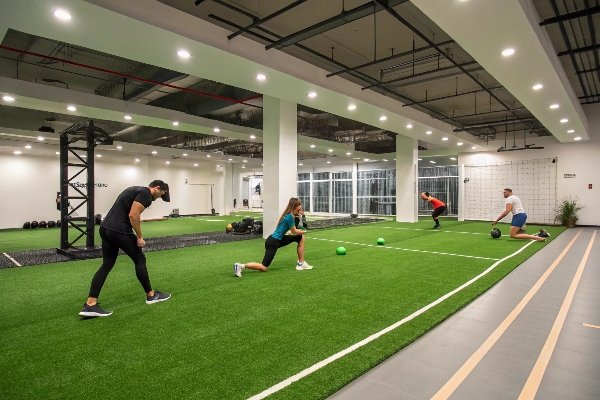
Real-world experiences offer valuable insights. Here are some examples and testimonials (simulated for illustrative purposes):
Gym Owner Testimonials (Simulated Examples):
-
Sarah J., Owner of "Functional Fitness Zone" (CrossFit Box): "We installed PLAE Attack Turf in our sled track and functional training area two years ago, and it’s been fantastic. The durability is incredible – it still looks new despite heavy daily use, including sled pushes and dropped weights (on rubber mats placed on turf for weightlifting zones). Our members love the feel and traction, and it really elevated the look of our box. Cleaning is a breeze – mostly just vacuuming. Highly recommend."
-
Mark L., Head Trainer at "Urban Athletic Club" (Commercial Gym): "We chose NexGen NX50 turf for our agility zone and group fitness studio. It provides excellent traction for our HIIT classes and agility drills. The padding option makes floor exercises more comfortable. It’s much more visually appealing than plain rubber flooring and creates a more energetic atmosphere. Maintenance is simple, and it’s holding up well to high foot traffic."
-
Jessica R., Home Gym Enthusiast: "I transformed my basement into a home gym and used Turf Solutions Group Fit Turf rolls. Installation was surprisingly easy DIY, and it completely changed the look and feel of my gym. It’s perfect for my bodyweight workouts, yoga, and light dumbbell training. Much better than working out on cold concrete!"
Online Review Snippets (Simulated Examples):
- "Great gym turf! Easy to install and looks amazing. Perfect for my home gym." – John D. (via online review platform)
- "Love the turf in my CrossFit gym. Sled pushes are so much better on turf than rubber. Durable and looks great." – FitnessFanatic88 (via gym forum)
- "Highly recommend NexGen turf for commercial gyms. Durable, good traction, and the padded option is worth it." – GymOwnerPro (via industry review site)
Key Takeaways from Testimonials:
- Durability is consistently praised: Gym turf holds up well under heavy use, sled pushes, and foot traffic.
- Aesthetics are a major plus: Turf enhances the gym’s visual appeal and creates a more motivating workout environment.
- Traction and performance benefits are noticeable: Members and trainers appreciate the improved traction for dynamic movements and exercises.
- Maintenance is generally easy: Turf is low-maintenance compared to other flooring options.
- Positive impact on member experience: Turf contributes to a more enjoyable and engaging workout environment.
Deeper Dive: Turf for Specific Gym Activities
Gyms aren’t one-size-fits-all. Different activities demand different flooring characteristics. Let’s analyze how artificial grass gym turf performs for specific exercises and training styles.
Artificial grass gym turf is highly versatile and well-suited for a wide range of gym activities. It excels in functional training, agility drills, sled pushes, speed training, and boot camp style workouts. While rubber flooring remains superior for heavy weightlifting, turf provides a more versatile and comfortable surface for most other gym exercises.
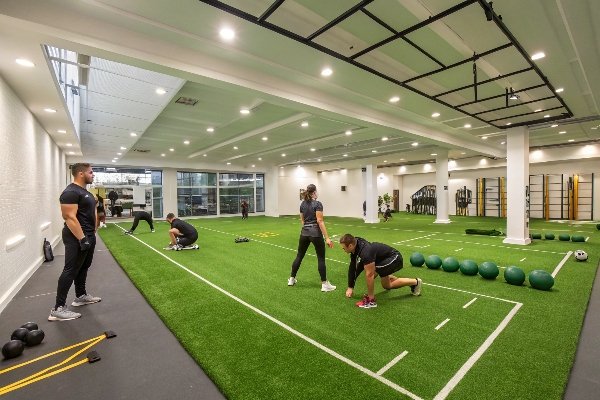
Let’s explore how turf performs for common gym activities and training styles.
Turf Performance for Specific Gym Activities:
- Sled Pushes/Pulls: Turf is IDEAL for sled work. Provides excellent traction for pushing and pulling sleds without excessive friction, allowing for smooth and effective sled training. Low pile turf is recommended for optimal sled performance.
- Agility Training: Turf offers excellent traction for agility drills, cone drills, ladder drills, and plyometrics. The stable surface allows for quick changes of direction and reduces slip risks. Low pile turf is preferred for agility.
- Functional Training/CrossFit: Turf is highly versatile for functional fitness workouts, bodyweight exercises, kettlebell training, and lighter dumbbell work. Provides a comfortable and durable surface for a wide range of movements.
- Speed and Sprint Training: Turf is suitable for sprint drills and speed training, offering good traction for acceleration and speed work. Shorter pile turf is recommended for optimal speed.
- Boot Camp/Group Fitness: Turf creates an energetic and versatile surface for boot camp style workouts, group fitness classes, and circuit training. Provides good traction and comfort for various exercises.
- Weightlifting (Light to Moderate): Turf can be used for lighter weightlifting exercises and dumbbell training. However, for heavy weightlifting with dropped weights, rubber platforms or mats placed on top of turf are essential to protect the turf and subfloor from impact damage. Turf itself is not designed to withstand direct heavy weight drops.
- Yoga/Pilates/Floor Exercises: Turf (especially with padding) can provide a more comfortable surface for floor exercises, yoga, and Pilates compared to hard rubber or concrete.
Turf vs. Rubber for Specific Activities:
| Activity | Best Flooring Choice | Why |
|---|---|---|
| Heavy Weightlifting | Rubber Flooring (or Rubber Platforms on Turf) | Unmatched impact resistance, protects subfloor from dropped weights |
| Sled Pushes/Pulls | Artificial Grass Turf | Optimal traction, smooth sled movement |
| Agility Training | Artificial Grass Turf | Excellent traction, stable surface for quick changes of direction |
| Functional Training | Artificial Grass Turf | Versatile, comfortable, good for a wide range of exercises |
| Speed/Sprint Training | Artificial Grass Turf | Good traction for acceleration and speed work |
| Boot Camp/Group Fitness | Artificial Grass Turf | Energetic, versatile, good for circuits and various exercises |
| Yoga/Pilates | Artificial Grass Turf (with padding) or Specialized Mats | More comfortable than hard surfaces for floor exercises |
Safety and Injury Prevention: Turf, especially when paired with padding, can help reduce joint stress compared to hard surfaces like concrete. The consistent surface and good traction minimize slip and fall risks. However, it’s still crucial to use proper form and appropriate footwear during workouts to prevent injuries. Turf can also help reduce ground burn compared to abrasive surfaces like concrete or asphalt.
Addressing Common Questions and Pain Points
Choosing gym turf comes with questions. How do you keep it clean? How long will it last? Let’s tackle common concerns and pain points to ensure you’re fully informed.
Common concerns about gym turf include maintenance, durability, odor control, and cost. However, high-quality gym turf is designed to be durable, easy to clean, and long-lasting with proper care. Addressing odor, ensuring good air quality, and understanding the long-term value are key to overcoming these potential pain points.

Let’s address some frequent questions and concerns I hear about gym turf.
Common Gym Turf FAQs and Pain Points Solved:
- Maintenance and Cleaning:
- Pain Point: Worried about turf getting dirty and smelly in a sweaty gym environment.
- Solution: Regular vacuuming (daily or weekly depending on traffic) is the primary maintenance. For deeper cleaning, use a mild detergent and water solution with a brush or mop. For spot cleaning spills, address them promptly. Proper ventilation in the gym helps reduce odor buildup. Consider antimicrobial turf options for enhanced hygiene.
- Odor Control:
- Pain Point: Concerned about gym odor getting trapped in the turf.
- Solution: Good ventilation is key. Regular cleaning as mentioned above. Consider using odor-neutralizing sprays specifically designed for synthetic turf (use sparingly and test in an inconspicuous area first). Proper sub-base drainage (if applicable) helps prevent moisture buildup that can contribute to odors.
- Durability and Lifespan:
- Pain Point: Unsure how long gym turf will last under heavy use.
- Solution: High-quality gym turf from reputable brands, especially polyethylene or nylon blends, is designed for durability. Lifespan depends on traffic, usage type, and maintenance, but expect 5-10+ years with proper care. Choose turf with a strong warranty (5+ years) as an indicator of durability.
- Environmental and Air Quality (VOCs):
- Pain Point: Concerned about chemicals and VOCs from synthetic turf, especially indoors.
- Solution: Choose turf with low VOC certifications (e.g., Green Label Plus). These certifications ensure the turf meets strict indoor air quality standards. Reputable manufacturers are increasingly using environmentally friendly materials and manufacturing processes.
- Noise and Vibration:
- Pain Point: Gyms can be noisy; worried about turf adding to the noise or vibration.
- Solution: Turf itself helps absorb some impact noise compared to hard surfaces. Adding padding or underlayment beneath the turf further reduces noise and vibration transmission, which is beneficial in shared buildings or home gyms.
- Cost vs. Long-Term Value:
- Pain Point: Initial cost of turf seems high compared to other flooring.
- Solution: Consider the long-term value. Durable turf lasts for years, reducing replacement costs. Low maintenance saves time and money. Improved gym aesthetics and member experience can lead to better client retention and business growth. Compare the total cost of ownership over 5-10 years to other flooring options.
Conclusion:
Choosing the best artificial grass gym turf is about finding the right balance of performance, durability, aesthetics, and budget for your specific needs. By understanding the different types of turf, installation methods, and key considerations, you can create a gym space that’s both functional and inspiring, enhancing workouts and member satisfaction for years to come.
